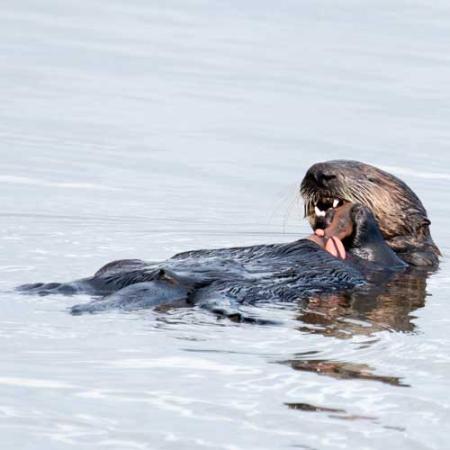Keith Aubry, research wildlife biologist with the U.S. Forest Service Pacific Northwest Research Station, has led a study to track wolverines found in Washington since 2006. Each winter, he and his team carefully live-capture wolverines, like “Logan,” the young male in the photograph to the right, to document their appearance, sex, age, and condition.
Many are fitted with a radio collar so the team can track their movement and learn more about their range. In addition, the researchers collect a small tissue sample from the ear to get a permanent molecular snapshot of the wolverine before releasing it back into the wild.
After doing some initial research, Aubry’s team sends the wolverine tissue samples to the Burke Museum where they are added to our Genetic Resources Collection, one of the largest of its type in the world. With tissue samples from more than 55,000 birds, 9,000 mammals, and 1,500reptiles and amphibians, the collection is essentially a library of biodiversity – and a resource for researchers everywhere.
Tissue samples contain valuable genetic information that can help researchers in many ways. For example, researchers might use this information to verify the identity of the animal, look at genetic diversity and trends across wolverine populations in Washington versus other populations, or even to do basic research on their genes to understand how they occupy a particular ecological niche.
The Burke's mammalogy collection has wolverine bone and skin specimens from past years, but Jeff Bradley, mammalogy collections manager, is particularly excited that these tissue samples come from wolverines still living in the wild – with some tissues coming from the same wolverine at different stages in its life.
This information, along with any bone or skin specimens the Burke might receive in the future, is a valuable resource for future researchers. “As technology improves, we are able to use our specimens to ask new questions," said Bradley. "In one-hundred years, researchers will be using our collections to answer questions we can't even dream of today."
More information about wolverines in Washington:
-
Once extinct here, wolverines on the rebound, The Seattle Times, January 31, 2013.
-
The Way of the Wolverine, Smithsonian Magazine, January 2012.
-
Wolverines breed, raise young in North Cascades, The Seattle Times, May 21, 2012
-
Wolverine-sized leap south, Conservation Northwest, April 12, 2012.
-
Washington's Wild One, by Keith Aubry, Conservation Northwest
Special thanks to Keith Aubry for contributing information and photos to this post.


